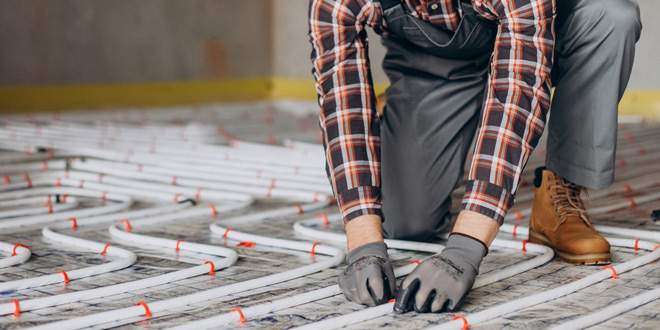
Considering a heating upgrade for your home? Underfloor heating might be the solution you’re looking for. Here, we’ll explore the benefits and drawbacks of underfloor heating, helping you make an informed decision for your comfort and efficiency needs.
What is Underfloor Heating?
Underfloor heating, also known as radiant floor heating, is an efficient method of warming a space by evenly distributing heat across the floor. There are two main types:
- Electric Underfloor Heating: Electric floor heating uses wires or mats installed beneath the floor, and is suitable for quick installation and retrofitting.
- Hydronic Underfloor Heating: These involve circulating warm water through pipes under the floor surface, and are ideal for new constructions and larger areas.
This system operates by spreading heat uniformly across the floor surface, a process of radiant heat transfer that avoids the uneven heat distribution common with traditional heating methods.
Pros of Underfloor Heating
1. Even Heat Distribution
Unlike traditional radiators, underfloor heating provides a uniform heat distribution across the room. This results in an evenly warmed space, eliminating cold spots and creating a more comfortable living environment.
2. Space Efficiency and Aesthetics
This system is installed beneath the floor, freeing up wall space that would otherwise be occupied by radiators or heating units. This hidden heating solution enhances the aesthetics of your home, allowing for more design freedom and uncluttered living spaces.
3. Energy Efficiency and Cost Savings
Underfloor/radiant floor heating systems operate at a lower temperature than standard radiators while still producing the same level of warmth. This efficiency can lead to reduced energy usage and lower heating bills, making it a cost-effective solution in the long term.
4. Improved Air Quality
While eliminating the need for high-temperature radiators, underfloor heating also reduces the circulation of dust and allergens in the air. This is particularly beneficial for those with allergies or respiratory issues, as it promotes a healthier indoor environment.
5. Comfort and Luxury
The sensation of warmth underfoot, a hallmark of heated floors, offers a feeling of luxury and comfort, especially during colder months. This type of underfloor heating provides a cozy, inviting atmosphere throughout your home, enhancing the overall comfort with its gentle, radiant warmth.
6. Compatibility with Various Floor Types
Underfloor heating systems are versatile and can be installed under a wide range of flooring materials, including tile, wood, laminate, and carpet, making them suitable for various home styles and preferences.
7. Zonal Heating Control
With the ability to control the temperature in different areas independently, underfloor heating allows for customized comfort and further energy savings. You can heat only the rooms in use, ensuring efficient use of energy.
8. Low Maintenance
Once installed, underfloor/radiant heat systems require minimal maintenance, providing a reliable and hassle-free heating solution for your home. If you live in Agua Dulce CA, learn more about heating maintenance service.
Cons of Underfloor Heating
1. Initial Installation Cost
The initial cost of installing underfloor heating, especially the hydronic type, can be higher compared to traditional heating systems. This includes the cost of materials and labor, which can be significant, especially in retrofitting scenarios.
2. Installation Complexity and Time
Installing underfloor heating, particularly the hydronic system, can be complex and time-consuming. It often requires significant alteration to the floor structure, which can be disruptive, particularly in existing homes.
3. Slower Heat-Up Time
Compared to traditional radiators, underfloor heating systems can take longer to warm up a room. This might not be ideal for those needing quick temperature increases, particularly in spaces that are not in constant use.
4. Floor Height Issue
The installation of underfloor heating can raise the level of the floor, which may be a concern in rooms with limited ceiling height or where door adjustments might be necessary.
5. Compatibility with Floor Finishes
Not all floor finishes are suitable for underfloor heating. Some materials, like certain types of wood, may not conduct heat effectively or could be damaged by the consistent heat exposure.
6. Difficulties in Repair
If issues arise, repairing an underfloor/radiant heating system, especially the electric type, can be challenging and disruptive, as it may involve lifting up parts of the flooring.
7. Limited Retrofitting Suitability
While electric radiant floor heating can be easier to install in existing homes, hydronic systems are generally more suited to new builds or major renovations due to the extensive work required.
8. Energy Source Dependency
The efficiency and cost-effectiveness of an underfloor/radiant floor heating system can depend on the energy source used. In areas where electricity is expensive, electric underfloor heating might not be the most economical option.
Ready to Upgrade Your Home Comfort?
It’s not ever a one-size-fits-all solution, but if you think underfloor heating is right for you, we will deliver. Elevate your living experience with the efficient, luxurious warmth of underfloor heating. At All Heart Heating & Cooling, we specialize in tailored heating solutions that align with your unique needs and preferences.
Contact us today to explore how underfloor heating can transform your home.




